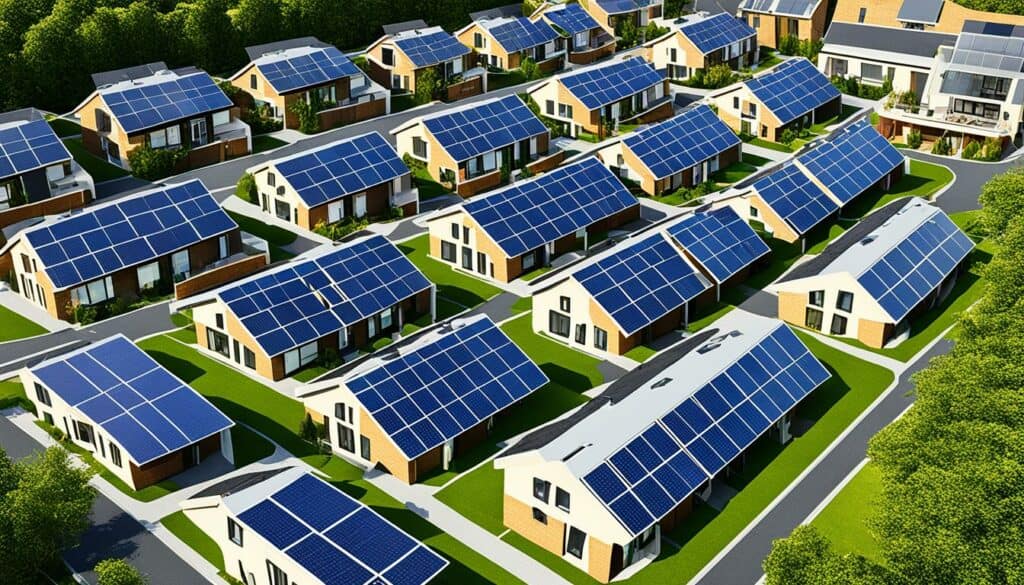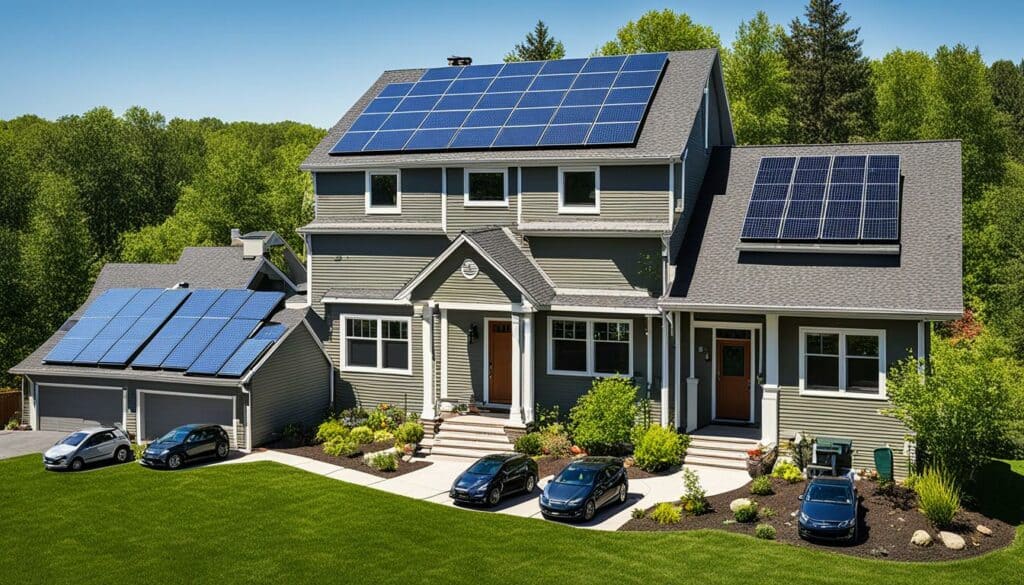Efficiency and Sustainability at Home: Essential Solar Devices for Every Household
Explore top solar devices for home to transform your living space into an eco-friendly hub. Embrace sustainability with residential solar power solutions.

As we confront climate change, it’s vital to have an eco-friendly home. Solar devices are now a real option for everyone. They make homes a source of green energy. By using residential solar power, homes become more independent and reduce their environmental impact. Modern living now means combining efficiency with caring for the planet.
Key Takeaways
- Solar devices help cut energy costs and promote sustainability.
- The power of residential solar keeps getting better, using the endless energy of the sun.
- Choosing sustainable technology benefits both the earth and your wallet.
- Eco-friendly solutions show our commitment to future generations.
- Solar gadgets are key in making homes greener and more self-reliant.
The Importance of Solar Energy for Sustainable Living
Embracing solar energy is key to sustainable development and caring for our environment. Solar power’s history shows our constant effort towards sustainability. The global move towards clean energy is clear with the support of international climate deals.
The History and Evolution of Solar Energy
The journey of solar energy from ancient times to today’s solar PV technology is amazing. The discovery of the photovoltaic effect in the 19th century was crucial. It led to the solar PV systems we use now. Because of this, solar energy is much cheaper today, making it more popular.
Home Solar Energy Systems in the Context of Global Sustainability
Using solar energy at home does more than just replace traditional energy. It’s vital for the world’s sustainability goals. It supports clean energy and helps build eco-friendly communities. Home solar energy not only benefits individual houses. It also creates jobs and makes our world greener and safer.
The Role of International Agreements in Advancing Solar Energy Usage
International climate deals play a big role in moving us towards renewable energy. The Paris Agreement and COP26 push for more solar energy use. They aim to cut carbon emissions and lessen climate change effects. These deals show solar energy’s key role in making our energy sources cleaner.
| Year | Solar PV Installed Capacity (GW) | Solar PV Electricity Generation Cost Reduction (%) |
|---|---|---|
| 2010 | 40 | – |
| 2018 | 4000 | 77 |
| Projection for 2030 | Expected Increase | Additional Reductions Forecasted |
Solar energy is important as we face climate change and a growing population. With its economic benefits and helpful policies, the future of solar energy looks bright. It continues to be a symbol of innovation and a hopeful path for sustainable living.
How Solar Devices for Home Contribute to Energy Independence

Many homeowners turn to residential solar panels as they seek energy independence. Generating your own power moves you away from relying on the usual grid electricity. This grid electricity typically comes from resources that won’t last forever. Solar panels help protect against the rising costs of utilities. They also support sustainable living for individuals and communities.
Home solar panel kits have made solar power accessible to more people. These kits include everything needed for a working solar system, like PV panels, inverters, and mounts. Thanks to their ease of use and affordability, these kits are great for DIY lovers and those watching their budget.
For many homeowners, the journey to relying less on outside energy sources goes like this:
- Start with a meeting and figuring out the best place for the panels
- Picking the right solar panel kit that fits the home’s energy requirements
- Setting up the panels, sometimes with local experts’ help or through DIY
- Starting to make electricity right away, which cuts down on energy bills
- Enjoying long-term perks like more home value, a smaller carbon footprint, and helping the planet
With more people using solar energy, we’re getting closer to a world powered by clean, renewable sources. This brings us more control over our impact on the planet and our finances.
Exploring the Different Types of Residential Solar Panels
The quest for residential energy solutions highlights a variety of types of solar panels. Each type has its own benefits and features. Whether you’re looking to save money, use space wisely, or keep your home looking great, there’s a solar option for every homeowner.
Monocrystalline vs Polycrystalline Solar Panels
Monocrystalline silicon panels are praised for their efficiency. This is because they’re made from a single silicon crystal. They need less space to produce a good amount of power. On the other hand, polycrystalline silicon panels are made from many silicon pieces. They’re a bit less efficient but are more affordable.
Building-Integrated Photovoltaics (BIPV): Merging Aesthetics and Efficiency
Building-integrated photovoltaics offer a great mix of good looks and energy production. These can be built into the structure of a home. They’re perfect for those who care about both power and appearance. However, keep in mind, they might cost more to install.
Thin-Film Solar Panels: The Future of Flexible Solar Tech
Thin-film solar cells represent a cutting-edge and flexible option. They can bend to fit different surfaces. This makes them perfect for places where regular panels won’t fit. They’re lightweight and easy to set up almost anywhere.
Yet, nearly half of U.S. homes can’t fit a standard rooftop solar setup. This might be because they’re renting or their roof isn’t right. But, community solar programs are helping many to use solar energy. These programs show that solar tech is becoming more accessible.
If you can put in solar panels, buying them directly often saves the most money. This can include tax credits and boosting your home’s value. To help understand your options, see the table below. It outlines key features of each solar panel type:
| Panel Type | Efficiency Rate | Cost | Best Use Scenario |
|---|---|---|---|
| Monocrystalline Silicon | High | Higher | Small Roof Spaces |
| Polycrystalline Silicon | Medium | Lower | Large Installations, Budget-Conscious |
| Building-Integrated Photovoltaics | Varies | Varies | Aesthetic Integration |
| Thin-Film Solar | Lower | Moderate | Flexible Surfaces, Temporary Installations |
Solar leases also make going solar easier by lowering upfront costs. This means fixed monthly bills for you. Solarize programs bring communities together to save on installation. Together, we’re moving towards greener energy sources.
Comparing Solar Power for Houses: Efficiency and Cost-Effectiveness
When looking at comparing solar power, homeowners often look at solar panel efficiency and cost-effectiveness of solar energy. This balance matters a lot because high-efficiency panels usually cost more. But sometimes, choosing less efficient panels can be smarter financially.

In sunny states like Arizona with good solar incentives, going solar is a smart move. But, it’s still key to calculate the cost per kilowatt-hour over the panel’s life. Doing this ensures the choice is both financially and environmentally smart.
Let’s compare some popular solar panel types. We’ll look at their efficiency, costs, and how much power they can produce:
| Panel Type | Efficiency | Cost | Annual Output (kWh) | Cost per kWh |
|---|---|---|---|---|
| Monocrystalline | 15-20% | High | 1,500 | $0.20 |
| Polycrystalline | 13-16% | Medium | 1,200 | $0.18 |
| Thin-Film | 10-13% | Low | 900 | $0.15 |
The most efficient panels aren’t always the best deal over time. For small rooftops, high-efficiency monocrystalline panels might be best. But for bigger roofs, cheaper polycrystalline panels might be better, thanks to the lower cost per kWh.
Choosing the right solar power system means thinking about both efficiency and the cost of solar energy. It’s not just about the efficiency rating. It’s about what makes the most sense financially and environmentally for your home.
When comparing solar power for homes, it’s key to consider not just the initial costs and efficiency. Look at the financial and environmental impacts over the system’s life.
Innovative Solar Energy Products for Eco-Friendly Home Solutions
Solar power has evolved beyond traditional panels. Now, innovative solar energy products are key for eco-friendly homes. These products lead the renewable energy revolution. They offer both practical use and care for the environment.
Integrating Solar Batteries for Enhanced Energy Storage
Solar batteries are vital for green living. They store extra solar energy for use anytime. This means homes can have power all the time. It makes home solar systems more reliable and flexible.
Solar batteries help us rely less on the grid. They make energy sustainability an around-the-clock goal. This moves us towards self-sufficiency.
Solar-Powered Appliances: From Lighting to Charging Stations
Solar-powered appliances make going green easier. They range from lights to charging stations. These appliances reduce carbon footprints and meet daily needs.
They work well with other solar products. This reduces grid power use. It sets a standard for green living.
The Numerous Benefits of Portable Solar Devices
Portable solar devices offer flexibility and convenience. They’re great for camping or emergencies. Devices like chargers, lights, and cookers are essential for those who love the outdoors and care for the environment.
These devices show that energy can be portable and eco-friendly. They turn sustainable living into reality.
Bringing solar energy into our homes balances efficiency and green living. Batteries, appliances, and portable devices are changing our energy use. They build a strong, eco-friendly energy system.
Conclusion
The path to sustainable living is through the use of residential solar energy. This move shows our growing care for the environment in daily life. Many solar technologies offer homeowners a way to join the green energy movement.
These green strategies let families take part in saving energy and protecting the environment. The growth of solar power technologies is impressive. Global support has sped up this growth, setting solar energy as a key piece of sustainability.
These advances mean solar tech is deeply woven into our homes. They help cut energy costs and lessen our impact on the planet.
Choosing solar power balances practical needs with caring for the environment. More homeowners see its value in helping the Earth and becoming energy independent. Thanks to effective and affordable solar options, greener energy is not just a dream. It’s changing how we use energy at home right now.


